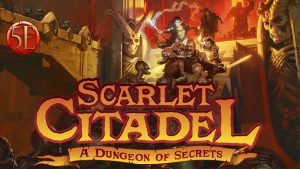
Some of the richest treasures in Scarlet Citadel are the additional rules. Steal liberally, and claim them for your own home game.
The earliest editions of the game had clear procedures for dungeon exploration. Turn by turn, players measured movement, tracked torches, and stumbled across random encounters.
5E addresses these things (kind of) but largely leaves it to an individual GM to figure out. This is great for customizing your experience, but it can perplex new GMs trying to figure out how to actually run the game. Scarlet Citadel has great resources to ease the burden in any dungeon!
Sound Advice
The first point that Scarlet Citadel addresses is sound. Combat is noisy! So what do creatures in nearby rooms do when they hear PCs slinging spells and exchanging blows with monsters? Three likely options:
1) join the fight
2) retreat to a defensible position or to stage an ambush
3) trigger a trap in the room where the characters are
Having clear choices at your fingertips makes it easier to pick one and go!
Light Work
The next point regards light. First, the text notes which areas of the dungeon complex have light. This sort of direct, easily referenced information is so helpful in the heat of running a game.
Steal this by making notes for any dungeon you run—published or your own. When you note the status of light clearly, you know where darkvision and light sources matter, and what characters see when they enter an area.
The ranges of common ways to deal with darkness include:
| Light Source | Bright Radius | Dim Radius |
| Oil lamp | 15 ft. | 30 ft. |
| Torches, light spell | 20 ft. | 20 ft. |
| Hooded lantern | 60 ft. | 60 ft. |
In addition, darkvision typically has a limit of 60 feet, all as dim light. This means everything is lightly obscured. Some creatures can hide when lightly obscured and Wisdom (Perception) checks are made with disadvantage. This is easy to forget in the thick of things, but it matters a lot for players who assume that darkvision means they don’t have to care about darkness.
Finding Secrets

Dungeon business like traps and secret doors can be troublesome given passive Perception scores. Does the rogue with a passive Perception of 20 find everything? That often turns out unsatisfying for everyone.
The Scarlet Citadel solution is ingenious. When a character approaches a trap or secret door, roll for the feature and compare the result to the character’s passive Perception score. The modifier on the roll equals the DC of the feature minus 8.
This mechanic can be used everywhere, always, forever. It solves all the problems of passive Perception in one elegant snap, adaptable to any trap or discovery.
No more, “Whoever is in the first rank, make a Perception check.” The players’ eyebrows speak before their mouths even open, and everyone has to struggle with metagaming. Using this method, the GM casually rolls, and the dice decide their fate. All as it should be.
Another concept for searches is to establish a clear procedure outside of the game. In Scarlet Citadel, the group gets only one chance to search for a trap, and only one chance to pick a lock. When a generous GM, recognizing that characters are under no particular time pressure, gives everyone a shot because it just makes sense, the increased probability of success wrecks designer intent and the feeling of challenge at the table.
Setting this sort of rule early in your campaign allows your players to set their expectations and approach exploration strategically. If lock picking fails, then what? Find another way around, break down the door, or risk the thunderous noise of a knock spell?
Choose a Better Way
A fundamental principle of good dungeoneering is to include meaningful choices. A great way to do that is to fill your own dungeon designs with alternate paths and nasty creatures that come calling when a door goes “BOOM!”
For example, Scarlet Citadel has notes on restocking the dungeon. Each dungeon level elaborates on this with specific suggestions to keep things interesting when players make repeated forays.
Don’t completely refill the dungeon! That makes progress impossible. Instead, denizens and newcomers should slowly fill emptied chambers, providing new challenges and shifting the state of the dungeon as a whole.
Table for Five
Scarlet Citadel contains other useful tables scattered throughout the book to pull out for your own use. As a rule of thumb, whenever you see a table in a published module, ask yourself: can I steal this? The answer is often yes!
- Level One has a d8 Burial and Treasure Table which can be used to quickly determine what lies within any crypt.
- Level Two has a triple-column d12 Alchemical Nonsense table. And if the party messes with the Pyramidal Stress Inverter one too many times, you can roll on the Furnace Malfunction table (“Uh oh, the furnace belches out toxic gas! Constitution saves, everyone!”)
- Level Five provides extractable tables for Void Madness and Item Curses. These aren’t as universally useful as the dungeoneering procedures, but when they work, they can make your players regret reading from the Fathomless Bloodbook in your home game.
Closing
With these ideas in mind, flip through some other adventures you might have, steal their procedures and generators, and make them your own!

“When a character approaches a trap or secret door, roll for the feature and compare the result to the character’s passive Perception score. The modifier on the roll equals the DC of the feature minus 8.”
I really LOVE the idea behind this, but do the maths stack up? Let’s use a scenario with a PC with a Perception mod of +10 and a secret door with a DC of 20 to find. RAW, the PC finds this secret door every time, as her passive Perception meets the DC. Using this variant, as the Friendly DM I roll d20 + 12 for the secret door (20 – 8 = 12), so she fails to find the secret door if I roll a 9 or higher (9 + 12 = 21, beating her passive Perception). That’s a big change in outcome probabilities! If a different door only requires a DC 15, that’s +7, so she fails to find it if I roll 14 or higher. Still a much different range of outcomes.
That doesn’t seem right.
I don’t know, it seems right to me. If the DC is 20 it is SUPPOSED to be hard to find, especially when just walking by….
For myself there is no such thing as ‘the DM casually rolls a die.’ That makes the players on edge and aware- which can be a good thing or a bad thing. I have taken to pre-rolling the dice a few times to have rolls ready on a list or, if on FG, rolling a physical die so either way if they are unaware, they are truly unaware.